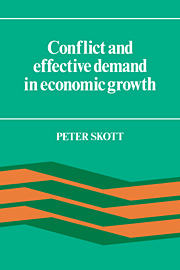Book contents
- Frontmatter
- Contents
- Guide to text notation
- Acknowledgements
- 1 Introduction
- 2 Methodological issues
- 3 A survey of some post-Keynesian and neo-Marxian ideas
- 4 The model
- 5 Ultra-short-run, short-run and steady-growth equilibria
- 6 Investment, instability and cycles
- 7 Finance and money-wage neutrality
- 8 Distributional questions in neo-Marxian and post-Keynesian theory
- 9 Final remarks
- Bibliography
- Index
6 - Investment, instability and cycles
Published online by Cambridge University Press: 05 January 2012
- Frontmatter
- Contents
- Guide to text notation
- Acknowledgements
- 1 Introduction
- 2 Methodological issues
- 3 A survey of some post-Keynesian and neo-Marxian ideas
- 4 The model
- 5 Ultra-short-run, short-run and steady-growth equilibria
- 6 Investment, instability and cycles
- 7 Finance and money-wage neutrality
- 8 Distributional questions in neo-Marxian and post-Keynesian theory
- 9 Final remarks
- Bibliography
- Index
Summary
INTRODUCTION
The preceding has examined the properties of ultra-short-run, short-run and steady-growth equilibria, but has not looked at stability issues in any detail. Will a sequence of ultra-short-run equilibria converge to a state of short-run equilibrium and will the economy approach steady growth asymptotically?
Following Harrod, many Keynesians have argued that the steady-growth path (the warranted path) is unstable. The empirical evidence, however, suggests that although both employment and production fluctuate significantly in advanced capitalist countries there is no monotonic divergence from some unstable steady-growth path. Furthermore, average growth rates appear to be broadly in line with the growth in the labour force.
The influence of the rate of employment on firms' production decisions can, as shown in the previous chapter, explain the consistency of warranted and natural growth rates, and as we shall see these class-struggle effects may also explain why Harrodian instability leads to fluctuations in production and employment rather than to monotonic divergence from steady growth.
The homeostatic effects of movements in the reverse army were emphasised by Marx in 1867 in his ‘general law of accumulation’ (see Marx, 1976, 23) and formalised by Goodwin (1967), but neither Marx's original argument nor Goodwin's formalisation took any account of Keynesian effective-demand problems (realisation problems). The Marxian mechanism can, however, be adapted and introduced into Keynesian models, and it is the purpose of this to do just that. Most of the building-blocks are already in place: the only piece missing is a full specification of the investment function.
- Type
- Chapter
- Information
- Conflict and Effective Demand in Economic Growth , pp. 89 - 113Publisher: Cambridge University PressPrint publication year: 1989



